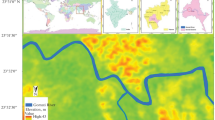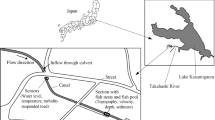Abstract
River confluences have complex hydrodynamics than ambient flows due to different flow characteristics of the two merging flows. Secondary circulation develops due to merging of two flows which leads to bed erosion. The eroded sediment gets deposited at various locations in the downstream of the confluence. It is reported in the literature that major reservoirs in India will lose 50% storage capacity by 2020 and reservoirs all over the world lose storage capacity by as much as 5% every year. In view of controlling bed erosion at the confluence, vane and circular pile models are used as scour mitigation structures and experimental results are presented. Experiments are performed in a distorted model with a non-uniform sediment of mean particle size d 50 = 0.28 mm with a confluence angle of 60°. Two different discharge ratios (Q r = ratio of lateral flow discharge to main flow discharge) of 0.5 and 0.75 are used with a constant flow depth (H m) of 5 cm in the main channel. Vanes of width 0.3H m (1.5 cm), thickness of 1 mm are placed at 15°, 30° and 60° vane angles with respect to main flow. Circular pile models of 8 and 12 mm diameter are also used. Two different spacing of 2H m and 3H m (10 and 15 cm) between the vanes or piles are used to perform the experiments. For Q r = 0.5 and 0.75 using vanes, scour depth reduces by 25 and 34%, respectively. When circular pile models of 8 and 12 mm are used, the scour depth reduces by 25, 38 and 27, 43%, for Q r = 0.5 and 0.75, respectively. The scour depth decreases with an increase of vane angle and pile diameter, but increases with an increase of spacing. Therefore, piles have better performance over vanes in reducing scour at the confluence.







Similar content being viewed by others
Abbreviations
- Lr :
-
Length scale
- Yr :
-
Depth scale
- d50 :
-
Mean particle size (mm)
- Hm :
-
Average flow depth in main channel in the upstream of the confluence (cm)
- Qm :
-
Main flow discharge (m3/s)
- Ql :
-
Lateral flow discharge (m3/s)
- Qd :
-
Downstream flow discharge (m3/s)
- Qr :
-
Discharge ratio
- Wm :
-
Average main flow width (cm)
- Wl :
-
Average lateral flow width (cm)
- Wd :
-
Average downstream flow width (cm)
- Va :
-
Vane angle (°)
- ɸ:
-
Pile diameter (mm)
- s:
-
Spacing between the models (cm)
- Sd :
-
Scour depth (cm)
- Sr :
-
Scour depth ratio = S d/H m
- Srmax :
-
Maximum scour depth ratio
- ds :
-
Local scour depth ratio = Local scour depth/H m
- V:
-
Mean flow velocity (m/s)
- F:
-
Froude number
- m:
-
Main channel
- l:
-
Lateral channel
- d:
-
Downstream channel
References
Joy DM, Townsend RD (1981) Improved flow characteristics at a 90° channel confluence. In: Proceedings of 5th Canadian Hydrotechnical Conference, Fredericton, NB, Canada, 781–792
Best J, Reid I (1984) Separation zone at open-channel junctions. J Hydraul Eng 110(11):1588–1594
Rhoads B, Sukhodolov A (2001) Field investigation of three-dimensional flow structure at stream confluences: 1. Thermal mixing and time-averaged velocities. Water Resour Res 37(9):2393–2410
Leite Ribeiro M, Blanckaert K, Roy A, Schleiss A (2012) Flow and sediment dynamics in channel confluences. J Geophys Res Earth Surf 117:1–19
Ramamurthy A, Carballada L, Tran D (1988) Combining open channel flow at right angled junctions. J Hydraul Eng 114(12):1449–1460
Hager WH (1989) Transitional flow in channel junctions. J Hydraul Eng 115:243–259
Taylor EH (1944) Flow characteristics at rectangular open-channel junctions. Trans ASCE 109:893–912
Schwalt M, Hager WH (1995) Experiments to supercritical junction flow. Exp Fluids 18:429–437
Best JL (1985) Flow dynamics and sediment transport at river channel confluence. PhD dissertation, Birbeck College, University of London, p 393
Modi PN, Ariel PD, Dandekar MM (1981) Conformal mapping for channel junction flow. J Hydraul Div 107(12):1713–1733
Bryan R, Kuhn N (2002) Hydraulic conditions in experimental rill confluences and scour in erodible soils. Water Resour Res 38(5). doi:10.1029/2000WR000140
Birjukova O, Guillen S, Algeria F, Cardoso AH (2014) Three dimensional flow field at confluent fixed-bed open channels. Proc River Flow, 1007–1014
Liu T, Chen L, Fan B (2012) Experimental study on flow pattern and sediment transportation at a 90° open-channel confluence. Int J Sediment Res 27(2):178–187
Qing-Yuan Y, Xian-Ye W, Wei-Zhen L, Xie-Kang W (2009) Experimental study on characteristics of separation zone in confluence zones in rivers. J Hydraul Eng 14(2):166–171
Hsu C, Wu F, Lee W (1998) Flow at 90° equal width open channel junction. J Hydraul Eng 124(2):186–191
Mignot E, Vinkovic I, Doppler D, Riviere N (2013) Mixing layer in open-channel junction flows. Environ Fluid Mech 14(5):1027–1041
Biron P, Best JL, Roy AG (1996) Effects of bed discordance on flow dynamics at open channel confluences. J Hydraul Eng 122(12):676–682
Đorđević D, Stojnić I (2016) Numerical simulation of 3D flow in right-angled confluences with bed elevation discordance in both converging channels. Procedia Eng 154:1026–1033. doi:10.1016/j.proEngineering2016.07.592
Weber L, Schumate E, Mawer N (2001) Experiments on flow at a 90° open-channel junction. J Hydraul Eng 127(5):340–350
Wang Xiekang, Wang Xianye, Weizhen LU, Liu, Tonghuan (2007) Experimental study on flow behavior at open channel confluences. Front Archit Civil Eng China 1(2):211–216
Liu T, Fan B, Lu J ( 2015) Sediment-flow interactions at channel confluences: a flume study. Adv Mech Eng 7(6), doi:10.1177/1687814015590525
Borghei S, Sahebari A (2010) Local scour at open-channel junctions. J Hydraul Res 48(4):538–542
Rhoads B, Kenworthy S (1995) Flow structure at an asymmetrical stream confluence. Geomorphology 11(4):273–293
Guillén-Ludeña S, Franca M, Cardoso A, Schleiss A (2016) Evolution of the hydromorphodynamics of mountain river confluences for varying discharge ratios and junction angles. Geomorphology 255:1–15
Roy A, Bergeron N (1990) Flow and particle paths at a natural river confluence with coarse bed material. Geomorphology 3(2):99–112
Rhoads B, Sukhodolov A (2004) Spatial and temporal structure of shear layer turbulence at a stream confluence. Water Resour Res. doi:10.1029/2003WR002811
Boyer C, Roy A, Best J (2006) Dynamics of a river channel confluence with discordant beds: flow turbulence, bed load sediment transport, and bed morphology J Geophys Res 111(F4). doi:10.1029/2005JF000458
Ramón C, Hoyer A, Armengol J, Dolz J, Rueda F (2013) Mixing and circulation at the confluence of two rivers entering a meandering reservoir. Water Resour Res 49(3):1429–1445
Parsons D, Best J, Lane S, Orfeo O, Hardy R, Kostaschuk R (2006) Form roughness and the absence of secondary flow in a large confluence–diffluence, Rio Paraná, Argentina. Earth Surf Process Landf 32(1):155–162
Schwalt M, Hager W (1995) Experiments to supercritical junction flow. Exp Fluids 18(6):429–437
Shakibainia A, Reza M, Tabatabai M, Reza Zarrati A (2010) Three-dimensional numerical study of flow structure in channel confluences. Can J Civ Eng 37:772–781
Shi-he L, Bing C (2011) ybrid simulation of the hydraulic characteristics at river and lake confluence, J Hydrodyn 23 (1), 105–113. doi:10.1016/S1001-6058(10)60094-7
Baranya S, Olsen NRB, Józsa J (2013) Flow analysis of a river confluence with field measurements and RANS model with nested grid approach. River Res Appl. doi: 10.1002/rra.2718
Lyubimova T, Lepikhin A, Konovalov V, Parshakova Y, Tiunov A (2014) Formation of the density currents in the zone of confluence of two rivers. J Hydrol 508:328–342
Chandra V, Mohapatra PK (2010) Predicting the evolution of suspended sediment concentration using artificial neural network. The Ninth International Conference on Hydro-Science and Engineering, IAHR, ICHE – 2010, IIT Madras, 2010, pp 1662–1670
Yang HC, Chen CW (2012) Potential hazard analysis from the viewpoint of flow measurement in large open-channel junctions. Nat Hazards 61(2):803
Balouchi B, Nikoo MR, Adamowski J (2015) Development of expert systems for the prediction of scour depth under live-bed conditions at river confluences: application of different types of ANNs and the M5P model tree. Appl Soft Comput 34:51–59
Gholami V, Chau KW, Fadaee F, Torkaman J, Ghaffari A (2015) Modeling of groundwater level fluctuations using dendrochronology in alluvial aquifer. J Hydraul 1060–1069(3):2015
Wang WC, Chau KW, Xu DM, Chen XY (2015) Improving forecasting accuracy of annual runoff time series using ARIMA based on EEMD decomposition. Water Resour Manag 2655–2675(8):2015
Bonakdari H, Zaji AH (2016) Open Channel junction velocity prediction by using a hybrid self-neuron adjustable artificial neural network. Flow Measur Instrum 49: 46–51
Mosley M (1976) An experimental study of channel confluences. J Geol 84(5):535–562
Nazari-Giglou A, Jabbari-Sahebari A, Shakibaeinia A, Borghei S (2016) An experimental study of sediment transport in channel confluences. Int J Sediment Res 31(1):87–96. doi:10.1016/j.ijsrc.2014.08.001
Ghobadian R, Bejestan MS (2007) Investigation of sediment patterns at river confluence. J Appl Sci 7(10):1372–1380. doi:10.3923/jas.2007.1372.1380
Roy A, Roy R, Bergeron N (1988) Hydraulic geometry and changes in flow velocity at a river confluence with coarse bed material. Earth Surf Process Landf 13(7):583–598
Kothyari UC (1996) Methods for Estimation Sediment Yield from Catchments. Proceedings of International Seminar on Civil Engineering Practice in Twenty First Century, Roorkee, India, 1996; 1071–1086
Wisser D, Frolking S, Hagen S, Bierkens M.F.P. (2013) Beyond peak reservoir storage: a global estimate of declining water storage capacity in large reservoirs. Water Resour Res 49:5732–5739. doi:10.1002/wrcr.20452
Jayaraman S (1995) Hydraulic modelling, Indian institute of Technology Madras, India
Shayan HK, Farhoudi J, Hamidifar H (2015) Estimation of maximum scour depth downstream of horizontal and adverse stilling basins using a semi-theoretical approach. Int J Civil Eng 13(1):1–15
Kazemi F, Khodashenas SR, Sarkardeh H (2016) Experimental study of pressure fluctuation in stilling basins. Int J Civil Eng 14:13–21. doi:10.1007/s40999-016-0008-3
Ikeda, S, Norihiro I, Rikio I (1991) Effects of pile dikes on flow retardation and sediment transport. J Hydraul Eng 117(11):1459–1478
Odgaard AJ, Wang Y (1991) Sediment management with submerged vanes. I: theory. J Hydraul Eng 117(3):267–283
Odgaard AJ, Kennedy JF (1983) River-bend bank protection by submerged vanes. J Hydraul Eng 109(8):1161–1173
Lane S, Parsons D, Best J, Orfeo O, Kostaschuk R, Hardy R (2008) Causes of rapid mixing at a junction of two large rivers: Río Paraná and Río Paraguay, Argentina, J Geophys Res 113(F2). doi:10.1029/2006JF000745
Vorosmarty CJ, Fekete BM, Tucker BA (1998) Global River Discharge, 1807–1991, V. 1.1 (RivDIS) Data set. http://www.daac.ornl.gov from Oak Ridge National Laboratory Distributed Active Archive Center, Oak Ridge, TN, USA, 1998. doi:10.3334/ORNLDAAC/199
Pinto Coelho M (2015) Experimental determination of free surface levels at open-channel junctions. J Hydraul Res 53(3):394–399
Ouyang HT, Lai JS, Yu H, Lu CH (2008) Interaction between submerged vanes for sediment management. J Hydraul Res 46:620–627. doi:10.3826/jhr.2008.3160
Odgaard AJ, Spoljaric A (1986) Sediment control by submerged vanes. J Hydraul Eng 112(12):1164–1180
Huang JK, Shi ZY (2001) The characteristics of the sand motion trained by bottom panel. J Sediment Res (in Chinese)
Bhuiyan F, Hey R (2002) Sediment transport in a meandering channel with instream hydraulic structures. In: Bousmar D, Zech Y (eds) Proceedings: river flow, II, pp 1091–1098
Tan SK, Yu G, Lim SY, Ong MC (2005) Flow structure and sediment motion around submerged vanes in open channel. J Water Ports Coast Ocean Eng 131:132–136. doi:10.1061/(ASCE)0733-950X(2005)131:3(132)
Gupta UP, Ojha CSP, Sharma N (2010) Enhancing utility of submerged vanes with collar. J Hydraul Eng 136(9):651–655
Allahyonesi H, Omid MH, Haghiabi AH (2008) A study of the effects of the longitudinal arrangement sediment behavior near intake structures. J Hydraul Res 46(6):814–819
Ghobadian R, Basiri M (2016) The effect of downstream curved edge on local scouring at 60 degree open channel junction using SSIIM1 model. Ain Shams Eng J 7:543–552. doi:10.1016/j.asej.2015.06.001
Hsu C, Wu F, Lee W (1998) Flow at 90° equal-width open-channel junction. J Hydraul Eng 124(2):186–191
Hager W (1987) Discussion of “Separation Zone at Open-Channel Junctions” by James L. Best and Ian Reid (November, 1984). J Hydraul Eng 113(4):539–543
Author information
Authors and Affiliations
Corresponding author
Rights and permissions
About this article
Cite this article
Wuppukondur, A., Chandra, V. Control of Bed Erosion at 60° River Confluence Using Vanes and Piles. Int J Civ Eng 16, 619–627 (2018). https://doi.org/10.1007/s40999-017-0147-1
Received:
Revised:
Accepted:
Published:
Issue Date:
DOI: https://doi.org/10.1007/s40999-017-0147-1




